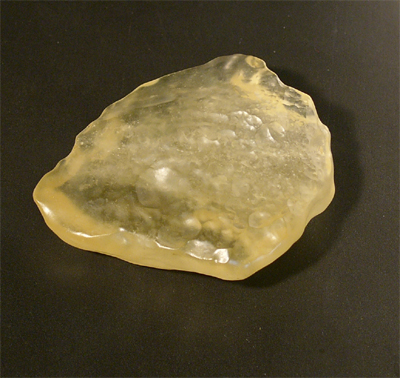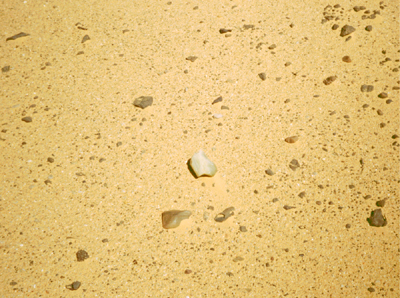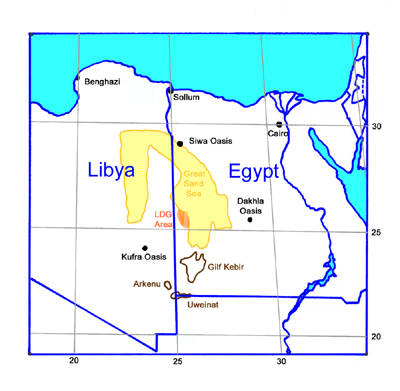 Patrick Clayton, a surveyor with the Egyptian Geological Survey, was one of a small number of pioneers who were probing the deep Sahara desert using specially built or modified cars. The prize for which they searched was the legendary oasis of Zerzura. An anonymous 15th century Arabic treasure seekers guide, "Kitab al Kdnuz" (The Book of Hidden Pearls) describes Zerzura as a whitewashed city of the desert on whose gate is carved a bird. the treasure seeker is advised to "take with your hand the key in the beak of the bird, then open the door of the city. Enter, and there you will find great riches..."
Patrick Clayton, a surveyor with the Egyptian Geological Survey, was one of a small number of pioneers who were probing the deep Sahara desert using specially built or modified cars. The prize for which they searched was the legendary oasis of Zerzura. An anonymous 15th century Arabic treasure seekers guide, "Kitab al Kdnuz" (The Book of Hidden Pearls) describes Zerzura as a whitewashed city of the desert on whose gate is carved a bird. the treasure seeker is advised to "take with your hand the key in the beak of the bird, then open the door of the city. Enter, and there you will find great riches..."
 Zerzura itself was never found. But in December 1932, Patrick Clayton was picking his way through the corridors between the long, windswept dunes of the Saad plateau, South of the Great Sand Sea, when he saw pieces of incredibly clear, yellow-green tinged glass in amongst the black, charred rocks of the desert floor. Clayton returned several times to collect samples of this glass, marking his last visit in 1934 with a note tucked into a whisky bottle. Fifty years later, the Italian archaeologist Giancarlo Negro was amazed to find the bottle, still with its note, sticking out of the sand. Negro's 1985 expedition was the first of a series made by scientists trying to unravel the mysteries of LDG. Since then, over 200 papers have been written on the mysteries of LDG.
Zerzura itself was never found. But in December 1932, Patrick Clayton was picking his way through the corridors between the long, windswept dunes of the Saad plateau, South of the Great Sand Sea, when he saw pieces of incredibly clear, yellow-green tinged glass in amongst the black, charred rocks of the desert floor. Clayton returned several times to collect samples of this glass, marking his last visit in 1934 with a note tucked into a whisky bottle. Fifty years later, the Italian archaeologist Giancarlo Negro was amazed to find the bottle, still with its note, sticking out of the sand. Negro's 1985 expedition was the first of a series made by scientists trying to unravel the mysteries of LDG. Since then, over 200 papers have been written on the mysteries of LDG.
The piece shown on the left is typical of the Libyan Desert Glass found laying in the sand. It is about 70mm long and 50mm wide. Due to the action of the wind and the sand, it has a slightly matt finish and all sharp edges and corners have been rounded off.
 So what is so strange about LDG that it excites so much intellectual curiosity? LDG is an amorphous glass of silicon dioxide, more commonly found in its crystalline form as quartz. Small pieces of silica glass are often found associated with lava flows which cool suddenly as they pour into the sea. The silicon in the lava freezes, forming an amorphous mass that resembles broken glass. These materials are about 75% silica, the rest being made up of crystals of quartz and oxides of aluminium and iron. Desert glass, by contrast, is 98% pure silica, the purest natural glass in the world. Also, this area of the Sahara is the largest known natural deposit of silica glass. It is estimated that there is over 1400 tonnes of it scattered over this part of the desert.
So what is so strange about LDG that it excites so much intellectual curiosity? LDG is an amorphous glass of silicon dioxide, more commonly found in its crystalline form as quartz. Small pieces of silica glass are often found associated with lava flows which cool suddenly as they pour into the sea. The silicon in the lava freezes, forming an amorphous mass that resembles broken glass. These materials are about 75% silica, the rest being made up of crystals of quartz and oxides of aluminium and iron. Desert glass, by contrast, is 98% pure silica, the purest natural glass in the world. Also, this area of the Sahara is the largest known natural deposit of silica glass. It is estimated that there is over 1400 tonnes of it scattered over this part of the desert.
This purity give the glass some remarkable properties. It can be heated up to 1700°C before it begins to melt, over 500°C higher than other natural glasses. It can be dropped into water when red hot and it will not disintegrate. High technology glasses struggle to do better.
Another oddity is the size of the chunks that can be found just laying about in the desert sand. Some pieces are as big as a football and can weigh in at over 25kg. These huge lumps of silica dwarf the small pieces found elsewhere in the world.
How LDG was formed in the first place is a mystery. Why did it form here and nowhere else? The composition and structure of the glass is consistent with the scenario that is was formed from melted dune sand, and then cooled over a period greater than 24 hours in an earth atmosphere. LDG has been dated at about 28.5 million years using fission-track dating. Fission-track dating is one type of radioactive dating method used by archaeologists to determine the age of artifacts containing uranium-bearing minerals. Small fission tracks through the glass left by decay products are created at a constant rate throughout time. So from the density of tracks present it is possible to determine the amount of time that has past since the track accumulation began.
One possible clue to the origin of LDG is the rare pieces which are smokey black or have black blobs and lines running through them. These dark samples are rich in iridium, which is typical of extra-terrestrial bodies such as meteorites or comets. Small pieces of shocked quartz have been found embedded in some samples of LDG, indicating a meteor impact origin. Silica glass has been found at other known meteor impact sites, but the glass there is blackened and fragmented, and is embedded in a matrix of fused and broken rock. LDG seems too clear and pure to have been created this way.
The problem with this explanation is that there are no known impact sites in the immediate area in which the LDG could have been created. The "Kebira" crater. recently discovered about 150km to the South West of the LDG area by Dr. Farouk El-Baz and his team at the Center for Remote Sensing at Boston University, may be a candidate. But the jury is still out on whether this, the "largest crater in the Great Sahara", is in fact a crater at all.
One possibility is that the meteor was chronditic - consisting of brittle stone and organic matter. The intense heat and massive compression shock that the meteorite would experience on entering the atmosphere could shatter and vaporise the meteor before it hit the ground. The resulting high temperature air-blast could possibly give the necessary heat to melt the glass and yet not leave an impact crater, though supporters of this scenario are driven to increasingly esoteric models in order to generate sufficient heat to create over a thousand tonnes of LDG.
The area in which LDG is found is also rich in artifacts left by man over the whole of pre-history. Stone knives, spear points, scrapers and arrow heads also litter the landscape. Highly prized though, are tools made from LDG. But these are comparatively rare - probably because LDG is not that tough as glasses go. It chips and breaks down relatively easily compared to the igneous rocks from which stone tools are usually made. However, as recently as 1998, it was discovered that a green scarab found amongst Tutankhamen's tomb goods was carved from LDG and not chalcedony, a form of quartz, as originally thought. This is the only known piece of Egyptian jewellary made from LDG. It is fascinating to wonder how this piece came out of the deep desert to end up in Tunankhamen's possession. Even today, LDG is difficult to find unless you are prepared to go out into the desert and find it for yourself. The market price for raw LDG is about $1.50 a gram.